Indian cuisine is celebrated for its rich flavors and diverse dishes, but not all options are equally healthy. For those in the Indian community in America looking to enjoy their favorite foods while maintaining a healthy diet, here are some recommendations for the best and worst Indian dishes for your health, along with tips for making healthier choices.
Healthiest Indian Dishes
- Dal-Based Dishes
- Health Benefits: Dal, which refers to lentils or a dish made from them, is a staple in Indian cuisine. Packed with protein, fiber, vitamin B6, and folate, dal dishes are nutritious and filling.
- Tip: Choose dal dishes with tomato-based sauces instead of creamy ones to reduce fat intake.
- Tandoori Proteins
- Health Benefits: Tandoori dishes, including chicken, fish, and lamb, are cooked in a tandoor (a traditional clay oven). This method uses high heat to sear the meat, retaining flavor without added fats.
- Tip: At home, replicate tandoori cooking by using a grill or oven broiler for a similar effect.
- Chana Masala
- Health Benefits: Chana masala is made from chickpeas, rich in folate, iron, fiber, and vitamin B. The dish’s tomato-onion base with garlic, ginger, and spices makes it both nutritious and delicious.
- Tip: Cook with fresh tomatoes and limit oil use for a healthier meal.
- Aloo Gobi
- Health Benefits: Combining potatoes and cauliflower, aloo gobi is seasoned with turmeric, ginger, garlic, and cumin, making it a heart-healthy and flavorful option.
- Tip: Use minimal oil and focus on fresh spices to enhance the dish’s natural flavors.
- Kebabs
- Health Benefits: Kebabs are a great source of lean protein. Grilling them keeps the fat content low while preserving the spices’ robust flavors.
- Tip: Serve kebabs with whole grain rice or a fresh salad to balance the meal.
Less Healthy Indian Dishes to Avoid
- Naan
- Why to Avoid: Though naan is a popular accompaniment, it is typically made with white flour, sugar, and oil, offering little nutritional value.
- Tip: Opt for whole wheat roti or chapati as healthier alternatives.
- Pakoras
- Why to Avoid: These deep-fried vegetable fritters are high in fat and calories, making them a less healthy choice.
- Tip: Bake pakoras using chickpea flour for a healthier version.
- Saag Paneer
- Why to Avoid: While spinach is healthy, the paneer (Indian cheese) and added cream make this dish high in fat.
- Tip: Substitute paneer with tofu and use low-fat yogurt to lighten the dish.
- Samosas
- Why to Avoid: These fried pastries are carb-heavy and high in fat.
- Tip: Bake samosas instead of frying and use whole wheat wrappers for a healthier option.
- Chicken Tikka Masala
- Why to Avoid: Often prepared with heavy cream and ghee, this dish can be very high in calories and fat.
- Tip: Make it at home with yogurt and limit the use of cream to reduce fat content.
- Pappadam
- Why to Avoid: Typically deep-fried, pappadam can be quite unhealthy.
- Tip: Roast pappadam instead of frying to keep it lighter.
- Lamb Rogan Josh
- Why to Avoid: The fat content in lamb, especially in fattier cuts, makes this dish high in fat.
- Tip: Use lean cuts like leg or loin and trim visible fat before cooking.
- Navratan Korma
- Why to Avoid: This vegetable dish is often finished with cream, adding extra calories and fat.
- Tip: Substitute cream with plain soy yogurt or blended tofu to make it healthier.
- Gulab Jamun
- Why to Avoid: These deep-fried dough balls soaked in syrup are high in sugar and fat.
- Tip: For a healthier dessert, try kheer (rice pudding) with fresh fruit.
Tips for Healthier Eating
- Portion Control: Many Indian dishes are served in large portions. Share an order or save half for another meal to reduce your calorie and fat intake.
- Home Cooking: Making dishes at home allows you to control the ingredients and cooking methods, ensuring a healthier meal.
- Healthy Substitutions: Use healthier substitutes like whole wheat flour, low-fat dairy, and lean cuts of meat to improve the nutritional profile of your favorite dishes.
By making informed choices and small adjustments, you can enjoy the rich and diverse flavors of Indian cuisine while maintaining a healthy diet.





